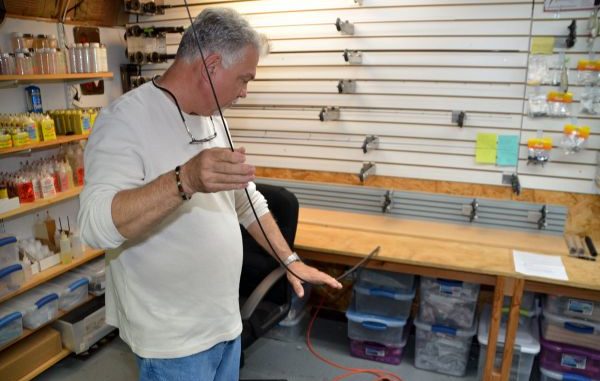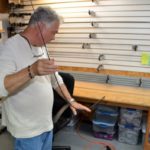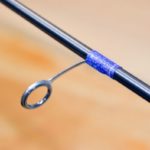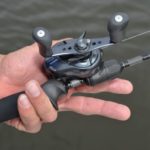
For some anglers a fishing rod is just a fishing rod. Their selection process is simple: They go into a store, pick up a rod without a reel and without any weight to load the tip and whip it up and down.
Others do more.
Lance Dupre of Swampland Tackle in Houma visibly cringed when he described what some anglers do.
“I’ve seen fishermen in tackle shops take the tip of the rod and see how far they can bend the tip back toward the butt,” Dupre said.
I had a whole afternoon to pick Dupre’s brain about rods at his workshop behind his Houma home. I wanted to know if there really were advantages to using a handcrafted rod over a store-bought or “rack rod.”
Like the professor of rods that he is (for a modest tuition fee, he teaches one-on-one classes on rod building), Dupre patiently dissected each component of a rod and their contribution to the finished product.
First was a lesson in semantics. I walked in using the word “custom rod.” But there is a difference, he explained, between a “custom rod” and a “handcrafted rod.”
Custom rod builders build rods to fit the body of the fisherman and highly decorate the rods they build. They are sizzlingly expensive.
Handcrafted rods are assembled from a choice of manufacturers’ components to meet the buyer’s needs for the kind of fishing he does. They are functional field rods and, although attractive, are not heavily decorated unless the buyer requests it. A typical handcrafted rod will set a buyer back $150 to $300.
Here are the three critical components that go into any handcrafted rod:
1) Rod blanks
Dupre makes some fiberglass rods, primarily for bass fishermen, but like other builders his bread-and-butter material is graphite.
Many grades of graphite exist, but most handcrafted builders use better-quality blanks — those more sensitive, durable and lighter than typically found on rack rods. Blanks for handcrafted rods can be selected for user fishing preference.
A critical difference between handcrafted rods and rack rods is the location of the rod’s spine. All graphite rod blanks have a spine, the stiff part located on one side or the other of the blank. Rack rods are assembled with little regard to the location of the spine.
In a handcrafted rod, the line guides are placed on top of the spine in casting rods and on the side opposite of the spine for spinning rods. This produces a stronger rod that is less likely to twist while a fish is being fought.
2) Guides
Line guides are often overlooked by rod purchasers, who are sometimes more interested in how a rod’s wiggle feels.
Buyers have to settle for whatever line guides the rack rod maker selects — often the cheapest. But line guides are critical to a rod’s performance, and handcrafted builders offer a wider choice of guides.
The frame for the guides that most builders use is 316 alloy stainless steel, but a choice of ring materials is available, ranging from the cheapest Hardloy to Alconite to silicon carbide.
Titanium guides are lighter than others and corrosion-proof. They come with silicon carbide rings, and have the advantage that braided lines will not cut a groove in the guide at the rod tip.
“In fact,” Dupre said, “a three-corner file won’t make a groove in it. But they come at a price — about triple that of a standard guide.”
Rod builders also offer a range of guide styles. Typical rack rods are built with variable size guides on their casting rods, progressing from size 12 (nearest the reel) down to size 6 (at the tip) on the same rod.
“For years and years this is how rods were made,” Dupre explained.
Micro guides, first popularized by custom rod builders but now offered by all handcrafted rod builders as well, are smaller — size 5 or less. And on a lot of rods the guides are the same size for the length of the rod. Dupre was one of the pioneers in their use.
Rods equipped with micro guides have less slap of the line on the rod as the line feeds out. This produces less friction, which in turn means longer casts and more accuracy. Micro guides have become so popular that some rack rods are now built with them.
Micro guides do have a drawback: Their small size doesn’t allow the passage of knots for heavy shock leaders, such as those used for large fish like redfish and black drum.
Consultation with a rod builder will determine whether micro guides are suitable for the application for which the rod will be used.
Spinning rod guides haven’t been neglected. Rod builders can install American Tackle Microwave guides. These unique guides hold the line well away from the rod, but they do much more.
The first guide up from the reel has a ring within a ring. Line coming off the face of a spinning reel comes off in large wobbling loops. These loops extend not just to the first guide, but to several guides beyond. The first microwave guide tames those loops, resulting in longer casts made with less effort. Casting accuracy is improved, as well.
Handcrafted rods offer advantages not only in guide selection, but in guide placement, as well. Spiral wrapping guides on casting rods so the first guide from the reel is on top of the rod and successive ones are placed twisting around the rod until the last several are on the bottom are still only available through custom and handcrafted rod builders. The advantage to this setup is that it eliminates the likelihood that a hard fighting fish will twist the rod.
Finally, handcrafted rods usually offer more guides per rod with better spacing than do rack rods. Ideally enough guides should be on the rod and they should be well-enough spaced so the line never touches the rod.
3) Reel seats & Grips
Reel seats are seldom considered important on a rod until one malfunctions, either dropping the reel or allowing the rod to twist in the seat.
Rack rods are built with tape or cardboard bushings that hold the rod blank in the seat for gluing. Both are susceptible to water damage.
Handcrafted rods, such as those Dupre builds, are constructed stronger, using a composite foam arbor instead of the bushings.
Handcrafted rods also offer more options in seats. For any rod blank, an angler has a choice of a non-exposed grip, an exposed grip or a two-piece grip. The first two are one-piece affairs, but the exposed grip has an open spot on its bottom to expose the rod blank to the angler’s finger for sensitivity. A two-piece grip likewise exposes the rod blank to the finger, and is also the lightest weight grip and reel seat.
Materials are also important. Cork for handles comes in three grades: AA, AAA, and fluor. The latter is the highest grade and mostly used in fly rods. AA with filler is what is often used in rack rods. Handcrafted rod builders often use AAA.
The story is the same with foam grips. Rack rods often use a soft foam. Rod builders have the option of using more dense EVA foam.
The latest trend, Dupre said, is putting golf grip in handcrafted rods.






